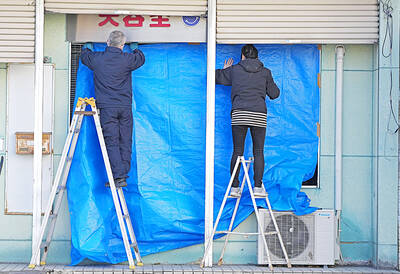Six people involved in clashes related to a Chinese music festival last year were sentenced to between 20 days in detention and jail terms of five months, all of which could be commuted to fines, the Taipei District Court said yesterday.
The six men included Chang Wei (張瑋), son of Chinese Unity Promotion Party (CUPP) founder Chang An-le (張安樂) — a former gang leader also known as the “White Wolf.”
Chang Wei was given 40 days in detention on charges of attacking and injuring several students who protested the holding of the “Sing! China: Shanghai-Taipei Music Festival” at the athletics field of National Taiwan University on Sept. 24 last year, the court said.
Lee Po-chang (李柏璋), a staunch pro-Taiwan independence advocate, received the same punishment as Chang for attacking and causing facial injuries to a CUPP member surnamed Yang (楊), who was attending the festival.
Lee was also accused by prosecutors of breaking Yang’s glasses during a scuffle between pro-unification and pro-independence crowds, after the festival was canceled due to the protest.
Hu Ta-kang (胡大剛), who assaulted a student that he thought was trying to help Lee, was sentenced to five months in jail for hitting the student with an extendable baton and to 20 days in detention on charges of intimidation for shouting at Lee’s girlfriend.
Three other individuals were sentenced to detentions ranging from 40 to 70 days, the court said, adding that the verdicts can be appealed.

Taiwanese were praised for their composure after a video filmed by Taiwanese tourists capturing the moment a magnitude 7.5 earthquake struck Japan’s Aomori Prefecture went viral on social media. The video shows a hotel room shaking violently amid Monday’s quake, with objects falling to the ground. Two Taiwanese began filming with their mobile phones, while two others held the sides of a TV to prevent it from falling. When the shaking stopped, the pair calmly took down the TV and laid it flat on a tatami mat, the video shows. The video also captured the group talking about the safety of their companions bathing

US climber Alex Honnold is to attempt to scale Taipei 101 without a rope and harness in a live Netflix special on Jan. 24, the streaming platform announced on Wednesday. Accounting for the time difference, the two-hour broadcast of Honnold’s climb, called Skyscraper Live, is to air on Jan. 23 in the US, Netflix said in a statement. Honnold, 40, was the first person ever to free solo climb the 900m El Capitan rock formation in Yosemite National Park — a feat that was recorded and later made into the 2018 documentary film Free Solo. Netflix previewed Skyscraper Live in October, after videos

Starting on Jan. 1, YouBike riders must have insurance to use the service, and a six-month trial of NT$5 coupons under certain conditions would be implemented to balance bike shortages, a joint statement from transportation departments across Taipei, New Taipei City and Taoyuan announced yesterday. The rental bike system operator said that coupons would be offered to riders to rent bikes from full stations, for riders who take out an electric-assisted bike from a full station, and for riders who return a bike to an empty station. All riders with YouBike accounts are automatically eligible for the program, and each membership account

A classified Pentagon-produced, multiyear assessment — the Overmatch brief — highlighted unreported Chinese capabilities to destroy US military assets and identified US supply chain choke points, painting a disturbing picture of waning US military might, a New York Times editorial published on Monday said. US Secretary of Defense Pete Hegseth’s comments in November last year that “we lose every time” in Pentagon-conducted war games pitting the US against China further highlighted the uncertainty about the US’ capability to intervene in the event of a Chinese invasion of Taiwan. “It shows the Pentagon’s overreliance on expensive, vulnerable weapons as adversaries field cheap, technologically